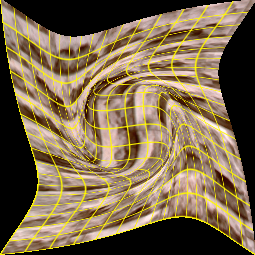ThinPlateSplineTransform
web-test/Cxx/PolyData/ThinPlateSplineTransform
Other languages
See (Java)
Question
If you have a question about this example, please use the VTK Discourse Forum
Code¶
ThinPlateSplineTransform.cxx
#include <vtkActor2D.h>
#include <vtkBMPReader.h>
#include <vtkDataObject.h>
#include <vtkImageBlend.h>
#include <vtkImageGridSource.h>
#include <vtkImageMapToColors.h>
#include <vtkImageMapper.h>
#include <vtkImageReslice.h>
#include <vtkInteractorStyleTerrain.h>
#include <vtkLookupTable.h>
#include <vtkNamedColors.h>
#include <vtkNew.h>
#include <vtkPoints.h>
#include <vtkProperty.h>
#include <vtkRenderWindow.h>
#include <vtkRenderWindowInteractor.h>
#include <vtkRenderer.h>
#include <vtkThinPlateSplineTransform.h>
#include <iostream>
#include <string>
// Warp an image with a thin plate spline.
int main(int argc, char* argv[])
{
vtkNew<vtkNamedColors> colors;
if (argc < 2)
{
std::cerr << "Usage: " << argv[0] << " Filename.bmp e.g. masonry.bmp"
<< std::endl;
return EXIT_FAILURE;
}
// First, create an image to warp.
vtkNew<vtkImageGridSource> imageGrid;
imageGrid->SetGridSpacing(16, 16, 0);
imageGrid->SetGridOrigin(0, 0, 0);
imageGrid->SetDataExtent(0, 255, 0, 255, 0, 0);
imageGrid->SetDataScalarTypeToUnsignedChar();
vtkNew<vtkLookupTable> table;
table->SetTableRange(0, 1);
table->SetAlphaRange(0.0, 1.0);
table->SetHueRange(0.15, 0.15);
table->SetSaturationRange(1, 1);
table->SetValueRange(0, 1);
table->Build();
vtkNew<vtkImageMapToColors> alpha;
alpha->SetInputConnection(imageGrid->GetOutputPort());
alpha->SetLookupTable(table);
vtkNew<vtkBMPReader> reader;
reader->SetFileName(argv[1]);
reader->Update();
auto dataExtent = reader->GetDataExtent();
// Use dataExtent[1] and dataExtent[3] to set the render window size.
vtkNew<vtkImageBlend> blend;
blend->AddInputConnection(0, reader->GetOutputPort());
blend->AddInputConnection(0, alpha->GetOutputPort());
// Next, create a ThinPlateSpline transform.
vtkNew<vtkPoints> p1;
p1->SetNumberOfPoints(8);
p1->SetPoint(0, 0, 0, 0);
p1->SetPoint(1, 0, 255, 0);
p1->SetPoint(2, 255, 0, 0);
p1->SetPoint(3, 255, 255, 0);
p1->SetPoint(4, 96, 96, 0);
p1->SetPoint(5, 96, 159, 0);
p1->SetPoint(6, 159, 159, 0);
p1->SetPoint(7, 159, 96, 0);
vtkNew<vtkPoints> p2;
p2->SetNumberOfPoints(8);
p2->SetPoint(0, 0, 0, 0);
p2->SetPoint(1, 0, 255, 0);
p2->SetPoint(2, 255, 0, 0);
p2->SetPoint(3, 255, 255, 0);
p2->SetPoint(4, 96, 159, 0);
p2->SetPoint(5, 159, 159, 0);
p2->SetPoint(6, 159, 96, 0);
p2->SetPoint(7, 96, 96, 0);
vtkNew<vtkThinPlateSplineTransform> transform;
transform->SetSourceLandmarks(p2);
transform->SetTargetLandmarks(p1);
transform->SetBasisToR2LogR();
// You must invert the transform before passing it to vtkImageReslice.
transform->Inverse();
vtkNew<vtkImageReslice> reslice;
reslice->SetInputConnection(blend->GetOutputPort());
reslice->SetResliceTransform(transform);
reslice->SetInterpolationModeToLinear();
vtkNew<vtkImageMapper> map;
map->SetInputConnection(reslice->GetOutputPort());
map->SetColorWindow(255.0);
map->SetColorLevel(127.5);
map->SetZSlice(0);
vtkNew<vtkActor2D> act;
act->SetMapper(map);
vtkNew<vtkRenderer> renderer;
renderer->AddActor(act);
renderer->SetBackground(colors->GetColor3d("SlateGray").GetData());
vtkNew<vtkRenderWindow> window;
window->SetSize(dataExtent[1], dataExtent[3]);
window->SetWindowName("ThinPlateSplineTransform");
window->AddRenderer(renderer);
vtkNew<vtkRenderWindowInteractor> interactor;
interactor->SetRenderWindow(window);
vtkNew<vtkInteractorStyleTerrain> style;
interactor->SetInteractorStyle(style);
window->Render();
interactor->Initialize();
interactor->Start();
return EXIT_SUCCESS;
}
CMakeLists.txt¶
cmake_minimum_required(VERSION 3.12 FATAL_ERROR)
project(ThinPlateSplineTransform)
find_package(VTK COMPONENTS
CommonColor
CommonCore
CommonDataModel
CommonTransforms
IOImage
ImagingCore
ImagingSources
InteractionStyle
RenderingContextOpenGL2
RenderingCore
RenderingFreeType
RenderingGL2PSOpenGL2
RenderingOpenGL2
)
if (NOT VTK_FOUND)
message(FATAL_ERROR "ThinPlateSplineTransform: Unable to find the VTK build folder.")
endif()
# Prevent a "command line is too long" failure in Windows.
set(CMAKE_NINJA_FORCE_RESPONSE_FILE "ON" CACHE BOOL "Force Ninja to use response files.")
add_executable(ThinPlateSplineTransform MACOSX_BUNDLE ThinPlateSplineTransform.cxx )
target_link_libraries(ThinPlateSplineTransform PRIVATE ${VTK_LIBRARIES}
)
# vtk_module_autoinit is needed
vtk_module_autoinit(
TARGETS ThinPlateSplineTransform
MODULES ${VTK_LIBRARIES}
)
Download and Build ThinPlateSplineTransform¶
Click here to download ThinPlateSplineTransform and its CMakeLists.txt file. Once the tarball ThinPlateSplineTransform.tar has been downloaded and extracted,
cd ThinPlateSplineTransform/build
If VTK is installed:
cmake ..
If VTK is not installed but compiled on your system, you will need to specify the path to your VTK build:
cmake -DVTK_DIR:PATH=/home/me/vtk_build ..
Build the project:
make
and run it:
./ThinPlateSplineTransform
WINDOWS USERS
Be sure to add the VTK bin directory to your path. This will resolve the VTK dll's at run time.
